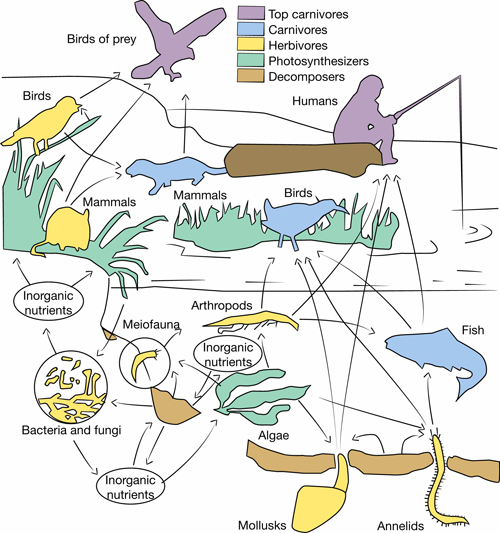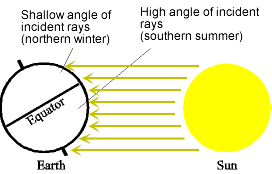 username@email.com
username@email.com
In the coming pages, we’ll examine several different natural cycles and see how they work in concert to promote and preserve life.
When functioning properly, the environment and ecosystem cycle vital nutrients and energy, providing a renewable supply of necessary products and mechanisms. Many of the processes are very complex, with subtle background processes and interactions not readily apparent but highly important to the functioning of the system. Let’s review some of the most important ones.
The water, or hydrologic, cycle is essential to life on earth, especially that of land animals including humans. Energy from the sun drives the process, through evaporation from oceans and surface water, photosynthesis in plants, and transpiration of water into the atmosphere. Because of the tilt of the earth’s axis, surface water and air are not heated evenly, resulting in seasons, major ocean currents, and weather phenomena such as clouds, wind, and precipitation.
As warm, moisture-laden air rises into the atmosphere, it is cooled and then falls back to earth as precipitation capable of replenishing ground and surface water supplies. Some returns to the oceans. Large areas of plant life, such as the tropical rainforests, are integral in transpiring water into the atmosphere and supplying much of the moisture needed for the rainfall that occurs at the tropical latitudes.
Water helps carry nutrients through ecosystems as it filters through soil and rock. If too much water filters through soil and rock, it can cause soil erosion or the removal of vegetation by wind or water. Soil erosion increases the sediment load of water, and nutrients are lost from the cycles in an ecosystem. Click here to see the hydrologic cycle.
Carbon is stored, or sequestered, in several places, often called reservoirs. During aerobic respiration, carbon dioxide (CO2) is given off as waste, releasing carbon from cellular metabolism. Volcanic eruptions, weathering, and burning of fossil fuels, in particular, release large amounts of carbon into the atmosphere. Photosynthetic organisms take up large amounts of carbon for incorporation into carbohydrates and then release oxygen as a by-product of photosynthesis.
Animals and other organisms utilize this oxygen in cellular respiration and excrete carbon dioxide as a waste product. As vegetation is removed through deforestation and as increasing amounts of carbon are released, photosynthetic uptake and carbon sequestering cannot keep up. The increase in carbon dioxide and other gases are believed to be responsible for increases in surface temperatures on earth. Click here to see the carbon cycle.
Rainforests move water into the atmosphere by
The correct answer is B. Transpiration occurs as plants take in water through their roots and move it out into the atmosphere through their stomata.
Most of the air you breathe is nitrogen. Essential to living organisms, nitrogen is a critical component of proteins and nucleic acids and is often in short supply. Despite their dependence on nitrogen, very few organisms can make any use of the atmospheric N2 form of nitrogen. They depend on the nitrogen cycle and the role of specific organisms to supply the nitrogen needed. There are several components of the nitrogen cycle, which converts atmospheric nitrogen to a useable form and eventually back to N2.
Nitrogen fixation is the conversion of N2 to ammonia (NH3) by several species of aquatic or terrestrial bacteria, either symbiotic with plants or living in the soil. NH3 can dissolve quickly in water and is converted to ammonium, which is then taken into the tissues of plants, such as soybeans, as well as organisms feeding on these plants in a process called assimilation. Nitrogen is also released through waste products when these organisms die and decompose. Thus, without the essential nitrogen-fixing organisms, modern agriculture often must add sufficient nitrogen to soils in order for food crops to grow.
Ammonification occurs when bacteria convert nitrogen from wastes or decomposition to NH3, which again is dissolved to form ammonium. Nitrification is the process of converting some of the ammonium in the soil into nitrates or nitrites that can then be assimilated by plants or animals. Denitrification occurs when other bacteria convert nitrates back to N2, which is then released into the atmosphere. Click here to see a NASA image of the nitrogen cycle.
Rainforests move water into the atmosphere by
The correct answer is C. Choices A, B, and D also describe different parts of the nitrogen cycle. Assimilation, however, refers to the taking in of nutrient material into the tissue of a living organism.
If an ecosystem is composed of many interactions between organisms and their environment, the most essential of these interactions is the flow of energy throughout the system.
As in the nitrogen cycle, sunlight is abundant on earth but available for use only by producers such as green plants and some bacteria and algae. Thus, while humans are the most evolved of species physiologically, we depend upon the actions of often very simple organisms for our survival.
The flow of energy from the sun to producers, consumers, and decomposers is often represented by a food chain, though the actual flow of energy is much more complex and is better represented by a still oversimplified food web.

Another revealing representation of energy flow is the energy pyramid. With most energy from the sun available to the producers, they are given the bottom portion of the pyramid. As you can see, only a fraction of the energy received by plants is actually available to herbivores, and even less is available to carnivores and decomposers.
Autotrophs are organisms capable of producing their own “food.” They would be considered
The correct answer is D. Primary producers are the first link in the food chain (and the first level of the food web). A plant is a good example of an autotroph—it uses photosynthesis to produce its own nourishment. The energy created by the plant travels up the food chain until it reaches the top predator level.
Within many ecosystems outside of the tropics, the flow of energy changes dramatically throughout the year. Winter represents the highest stress time for many organisms; most plants either die or become dormant, while animals either migrate, hibernate, or deal with the harsh conditions. Nutrients are still available in dormant or even dead plants but often the plants are buried under snow or are very scarce. Some species will switch diets, while others will live off of fat reserves built up during the warmer seasons and feed very little.

Summer and fall are critical times for hibernating and non-hibernating organisms to obtain sufficient energy to recover from winter stress, breed, raise young, and gain fat levels needed to survive the next winter.
In some animals, such as elk, insufficient fall preparation creates a much lower chance of surviving the winter. Some will not breed in the fall because their nutritional level is so poor. The length of daylight hours drives migration patterns of many birds, but as global temperatures have increased so have soil temperatures and vegetation emergence. Insect emergence is beginning to occur before some migratory species move through; The peak availability of food is no longer in sync with the hatching of young.
How might the energy pyramid look if it showed the actual number of organisms in an ecosystem instead of the amount of energy available to each?
The correct answer is A. Because less energy is available to top consumers, an ecosystem can support far fewer of these organisms than it can plants and herbivores.